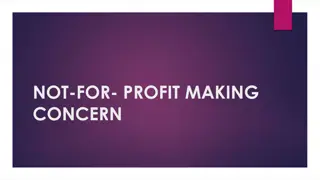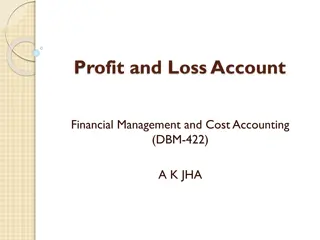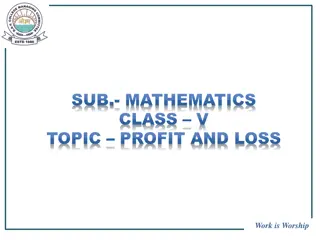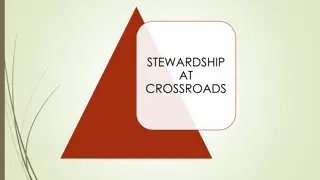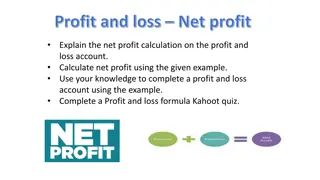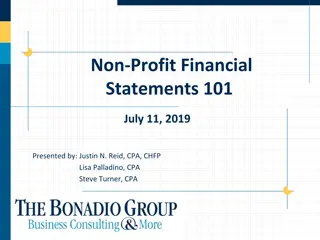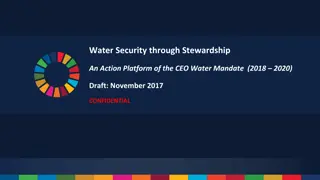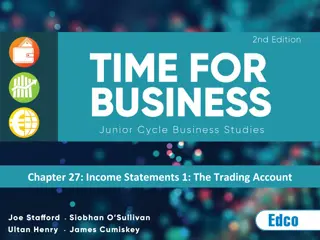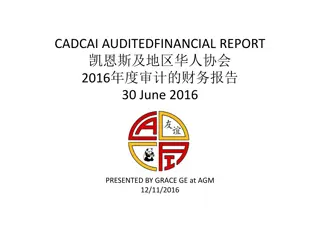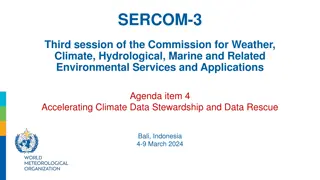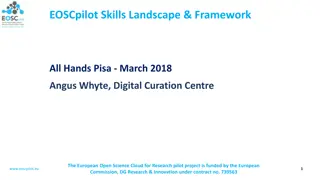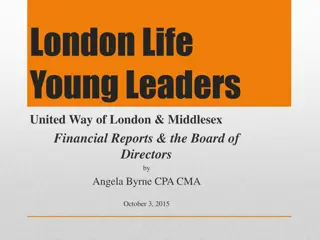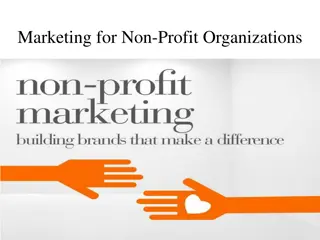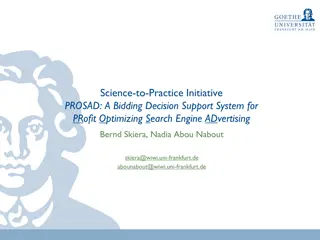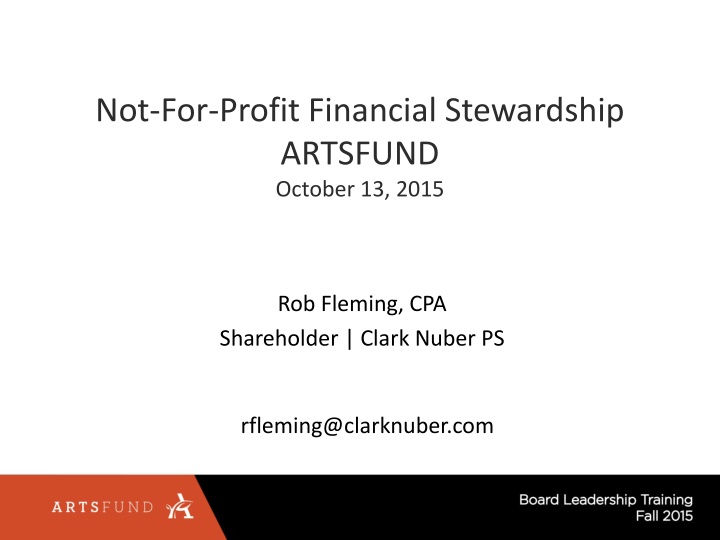
Financial Stewardship in Not-for-Profit Organizations
This content discusses financial stewardship in not-for-profit organizations, including board responsibilities, ethical behavior, compliance with laws, and recent examples. It also covers goals such as accountability, transparency, sustainability, prudent financial behavior, and monitoring of budgets and expenses.
Download Presentation

Please find below an Image/Link to download the presentation.
The content on the website is provided AS IS for your information and personal use only. It may not be sold, licensed, or shared on other websites without obtaining consent from the author. If you encounter any issues during the download, it is possible that the publisher has removed the file from their server.
You are allowed to download the files provided on this website for personal or commercial use, subject to the condition that they are used lawfully. All files are the property of their respective owners.
The content on the website is provided AS IS for your information and personal use only. It may not be sold, licensed, or shared on other websites without obtaining consent from the author.
E N D
Presentation Transcript
Not-For-Profit Financial Stewardship ARTSFUND October 13, 2015 Rob Fleming, CPA Shareholder | Clark Nuber PS rfleming@clarknuber.com
AGENDA Duties Of Board Financial Responsibilities Reading Financial Statements IRS Form 990 Internal Controls Risk Management
BOD RESPONSIBILITIES Duty Of Care Duty Of Loyalty Duty Of Obedience (Topic is covered in legal session)
BOD RESPONSIBILITIES Hire, coach and evaluate the executive director Develop mission, vision, values, and policies Develop strategic plan Assure financial stewardship Fundraise Be an advocate Ensure BOD s own effectiveness
WASHINGTON ATHLETIC CLUB Mission To enrich the quality of life of our members Vision To be the premier athletic club in America Values Leadership, excellence, integrity, service, and sensitivity
COMMON BOARD CONCERNS Accountability and Transparency Sustainability Prudent Behavior Ethical Behavior Compliance with Laws and Regulations
RECENT EXAMPLES Penn State/Second Mile Susan G. Komen Foundation Archdiocese Of New York
FINANCIAL STEWARDSHIP GOALS Accountability and Transparency Financial reports are accurate, complete, timely, and useful Monitor internal controls Communicate with auditors
FINANCIAL STEWARDSHIP GOALS Sustainability Review, approve and monitor operating and capital budgets Monitor cash flows (both investment policies and debt policies) Prudent Behavior Expenses are reasonable and necessary Approve major transactions
FINANCIAL STEWARDSHIP GOALS Ethical Behavior Monitor issues relating to conflicts of interest, code of ethics, whistleblower reports, and excessive compensation Compliance with Laws and Regulations Monitor compliance reporting Implement record retention/destruction policy
TEXAS INSTRUMENTS ETHICS TEST Is the action legal? Does it comply with our values? If you do it, will you feel bad? How will it look in the newspapers? If you know it s wrong, don t do it If you are not sure, ask Keep asking until you get an answer
DISCUSSION What financial issues/practices have you seen in your work with nonprofits that are troubling to you?
BEST PRACTICES National Corporate governance proposals of Senate Finance Committee did not become law Independent Sector in October, 2007 issued: Principles of Good Governance and Ethical Practice: A Guide for Charities and Foundations
BEST PRACTICES Report Contains 33 Suggested Practices Legal Compliance Effective Governance Financial Oversight Responsible Fundraising See full report at: Independentsector.Org
LEGISLATION IN WASHINGTON State legislature amended RCW19.09, the state law that governs charitable solicitations Goal is to increase accountability and transparency of nonprofit organizations Does not apply to churches or to organizations that do not solicit contributions from the public
LEGISLATION IN WASHINGTON Financial Reporting If average revenues are more than $1m, must have independent review of tax return If average revenues are more than $3m, must have independent audit of financial statements
LEGISLATION IN WASHINGTON Other Requirements Revised reporting requirements for commercial fundraisers Educational program for charities, boards, and general public Board member must sign reports submitted to State
WHAT IS UNIQUE ABOUT NONPROFITS? Purpose other than to make a profit Tax deductible contributions No ownership Special tax benefits
ACCOUNTANTS REPORTS Audit - highest level Review - analytics and inquiry Compilation - no assurance No accountant s report financials prepared internally
COMPONENTS OF FINANCIAL STATEMENTS Balance Sheet Detail of assets, liabilities, and equity (net assets) Represents a point in time Indicates future cash flow
COMPONENTS OF FINANCIAL STATEMENTS Statement of Activities Shows revenues and expenses over a period of time Shows revenues by restriction Shows expenses by function (program and administration/fundraising)
COMPONENTS OF FINANCIAL STATEMENTS Statement of Cash Flows Summary of changes in cash during the period
COMPONENTS OF FINANCIAL STATEMENTS Footnotes Description of business and operations Description of accounting policies Detail of balance sheet amounts Unusual events and contingencies
DISCUSSION If you were a new member of the Seattle Rep Board and were given its financial statements, what would you notice or conclude about the organization?
IRS FORM 990 Same information as financial statements Also provides information on compensation, donors, expenses by category, and board members 17 questions on corporate policies now on form Form is receiving much more attention IRS revised the form for 2008
MAINTAINING YOUR EXEMPT STATUS Follow mission No political activity Limited unrelated activity No self inurement Comply with IRS and State requirements
INTERNAL CONTROLS Active involvement by management Perform background checks Have two people process cash receipts Examine support for all disbursements Separate control of assets from accounting
INTERNAL CONTROLS Review unopened bank statements Approve all adjustments and write-offs Compare actual results to budgets Relate financial results to service efforts and accomplishments
ENTERPRISE RISK MANAGEMENT Process of identifying, mitigating and monitoring risks that could have a significant impact on your organization Board should be asking three questions: What are our major risks? How do we know we have identified all risks? What is our mitigation plan to reduce identified risks?
ENTERPRISE RISK MANAGEMENT Mitigation options Avoidance Share the risk Insurance Joint venture Reduce the risk Limit the involvement Diversify Acceptance
ENTERPRISE RISK MANAGEMENT Discussion: What would be some examples of risks for nonprofits that should be addressed?
THANK YOU Questions?

